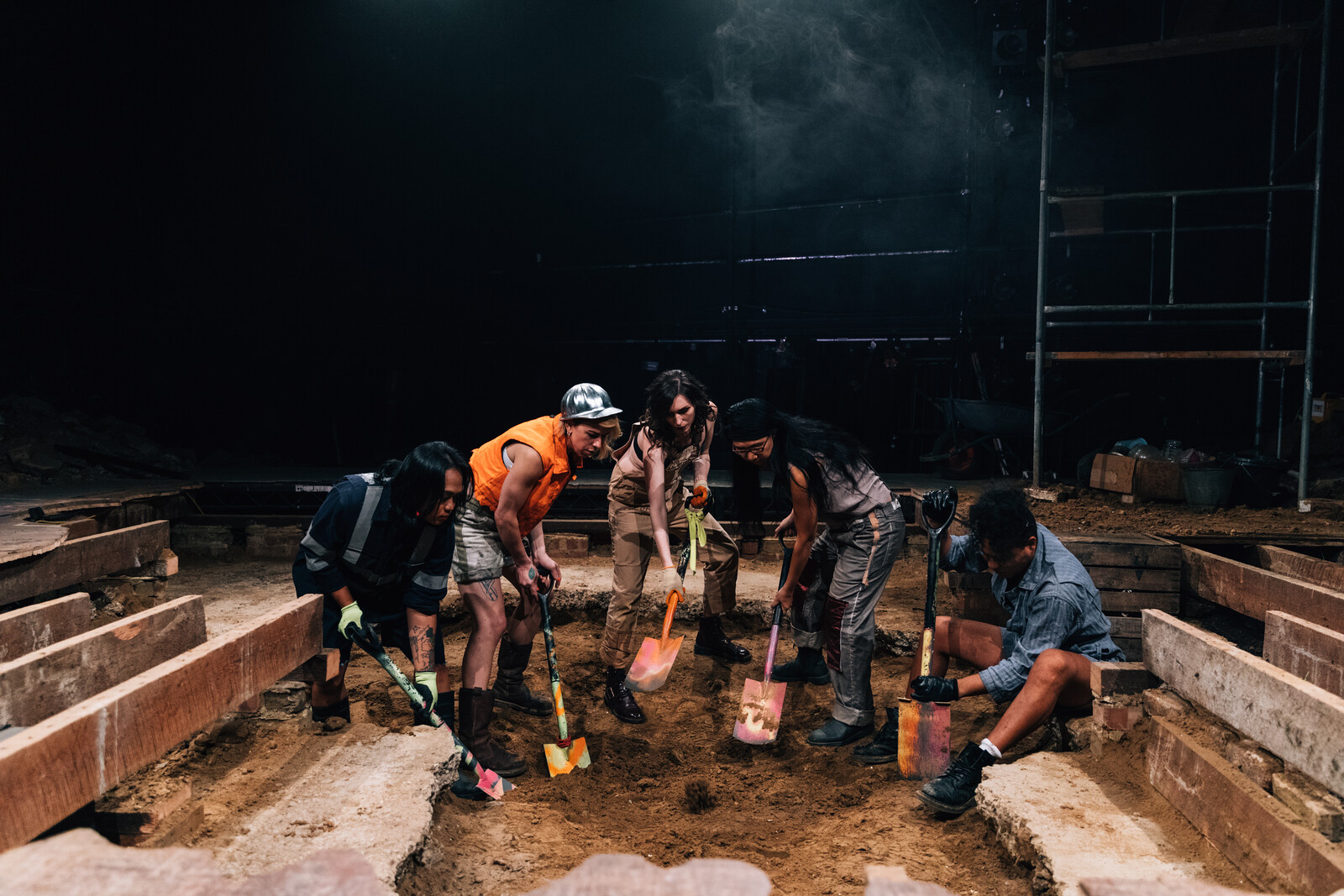We have known each other a long time, but it was in 2019, when I saw the Ludruk Desa Festival in Jombang, that we reunited and I found out that Tamarra was researching cross-dressing culture. We first met in 2014 in Bandung, Indonesia. At the time, Tamarra was preparing for an event called Bandung New Emergence Volume 5, part of an exhibition at Selasar Sunaryo Art Space, working with fellow artist Mulyana under the name marayana (Tamarra and Mulyana). Our introduction started with a can of beer. Since we live and work in different cities, I can only follow Tamarra’s work from afar. Tamarra is a performance artist who works with identity and body. Together with nonbinary friends, Tamarra formed a singing group that goes by the name AMUBA, which Vice Indonesia and Vice Asia covered in 2019.1 As Tamarra recalls:
I thought the name had at least two meanings. The first is that the amuba (“amoeba” in English) is a flexible creature. It is unicellular. In human language, “amuba” doesn’t have a singular gender. Amuba don’t have to choose any gender. An amuba can reproduce itself. Second, the fun part, which is “Amukan Banci.” It’s hard to translate, but maybe “Shrieking Sissy” would fit best.
Today we sit down to talk about Tamarra’s involvement in non-binary communities and ongoing work on how they live their lives in different cultures and ethnicities in several regions in Indonesia. The journey started in 2016 in Sulawesi, with the Bissu community, and continued with the ludruk art troupe in Jombang and Mojokerto, both located in East Java. Now it’s on hiatus due to the pandemic.
The conversation centers on ludruk, a traditional art originating in East Java performed by groups of male and nonbinary actors portraying female characters. Traveling from stage to stage, ludruk troupes bring with them critical social commentary, stories of everyday folk life, and vernacular jokes accompanied by gamelan music.
As a consequence of so-called civilization and modernity, we are now dealing with the erasure of customary cultural and aesthetic forms.
I can see enthusiasm resonating throughout the country and abroad for what Tamarra is doing with the spirit of ludruk: the preservation of value, resistance by existence, and countering the dominant, populist systems of social and cultural order brought by the elite.
—Riksa Afiaty
Riksa Afiaty: We met in Jombang during the Ludruk Festival, and since then I’ve been following your work on transgender women’s culture and crossdressing. But first, let’s talk more about your research in East Java.
Tamarra: Ludruk is a performing art that functioned as public entertainment in the colonial era. You can find it easily in Indonesia’s East Java region, especially Jombang and Mojokerto. Ludruk involves transgender women, who in this context are called various local terms: “tandak,” “travesti,” “siban,” “banci,” or “waria.” The term “waria” is a combination of the Indonesian words “wanita” (woman) and “pria” (man).2
When did the waria culture emerge? Around 1910, a farmer named Santik began hustling as a lerok, a busker who paints his face with makeup. After a while, Santik’s creation attracted many people and was well-received by audiences in the market, where he always performed. Santik performed a play, creating a character called Besut through which he narrated a story in kidungan, or singsong—at times in rhyme. “Besut” then became “Besutan,” which refers to a form centering on a one-man narrator who tells a story that conveys good values or messages of struggle.
Apart from Besutan, Santik created a female figure named Rusmini, who was a symbol of the homeland or motherland. At that time, it was very difficult to find actresses, so men dressed up to play Rusmini.
Santik used his performance not only as entertainment, but also as a medium for resistance to colonialism. Santik was the great-grandson of Mbah Sadran, who fought under the leadership of Pangeran Diponegoro during the Java War (1825–30, against the Dutch Empire).
RA: The historian Benedict Anderson has said that in Indonesia there is a belief that people who can fuse the elements of woman and man are extraordinary humans, who can directly relate to the supernatural world.3 How do you see this position? Has it evolved? If so, what still remains?
T: I traveled to South Sulawesi to meet other nonbinary people. There I learned that in the past they had a noble position as the mediators between kings and the gods or goddesses. They are still cultural stakeholders, but their roles are more diverse today, ranging from farmers to beauty parlor owners.
You might recall the notion of bissu, right? South Sulawesi peoples have five genders: oroane, or male; makkunrai, or female; calabai, or men with feminine gender expression; calalai, or women with masculine gender expression; and bissu, which is the fifth gender, and which symbolizes the completion of a gendered balance.
I first went there for personal reasons, in 2016. I was so frustrated about my sexual orientation and felt it was so hard to build a relationship with a man. I heard that there were sacred transgender women who were celibate. That was the first reason, actually: I wanted to learn how to be celibate. There is no knowledge about being celibate in Islam, and of course I can’t learn from the Catholic institution. I was also curious about how bissu live their lives. Then I learned about La Galigo.4 It is a manuscript or book from the ancient Bugis culture that tells the story of the five genders, including the bissu.
However, today there are two different versions of La Galigo, one of which is the Islamic version. Some of the original version is still stored in Kotabaru, South Sulawesi, while the largest part of the manuscript is in the Netherlands. That version is still being translated into Indonesian and English. It is important to note that some indigenous peoples still practice their ancestral beliefs.
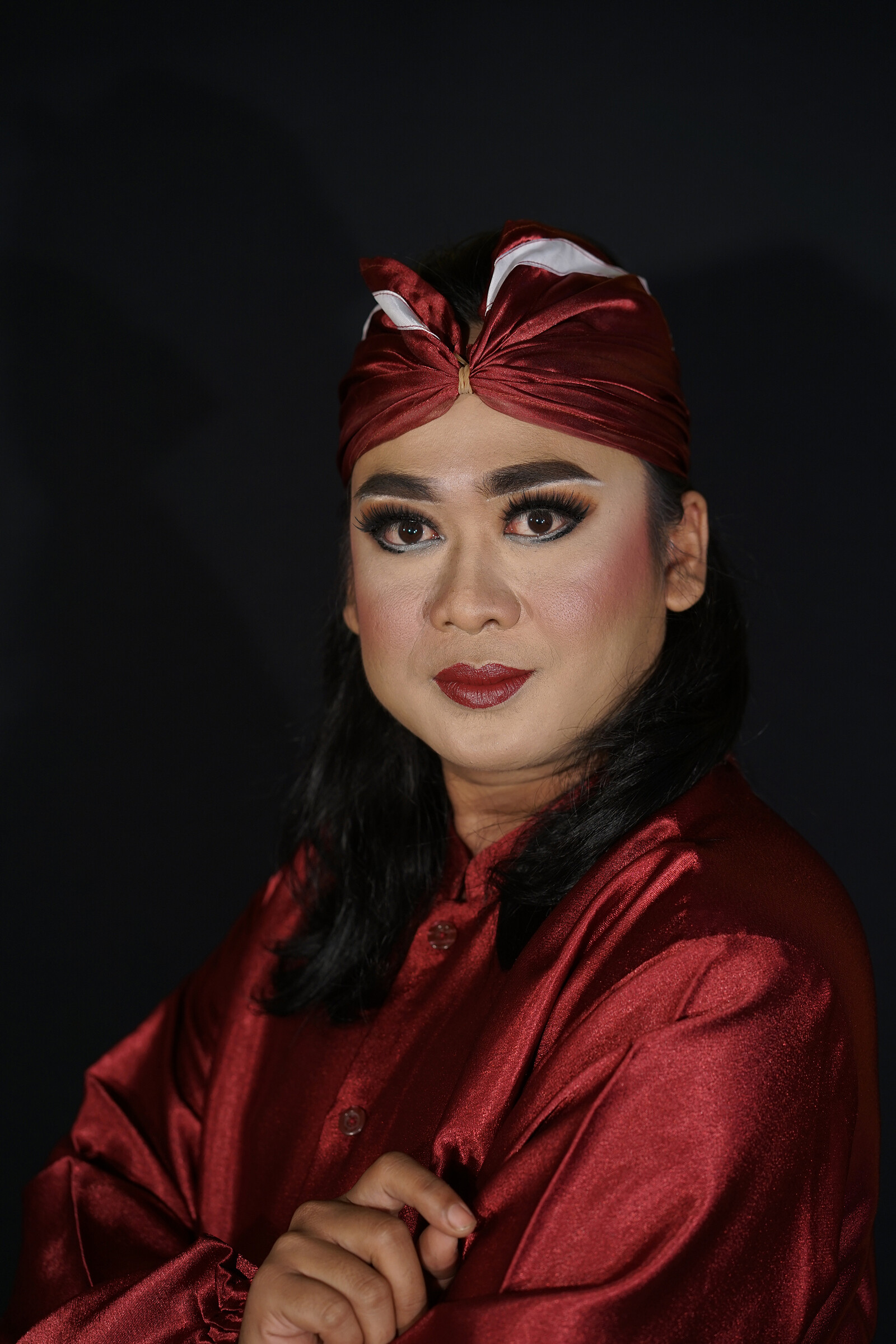
Photograph series courtesy of Tamarra.
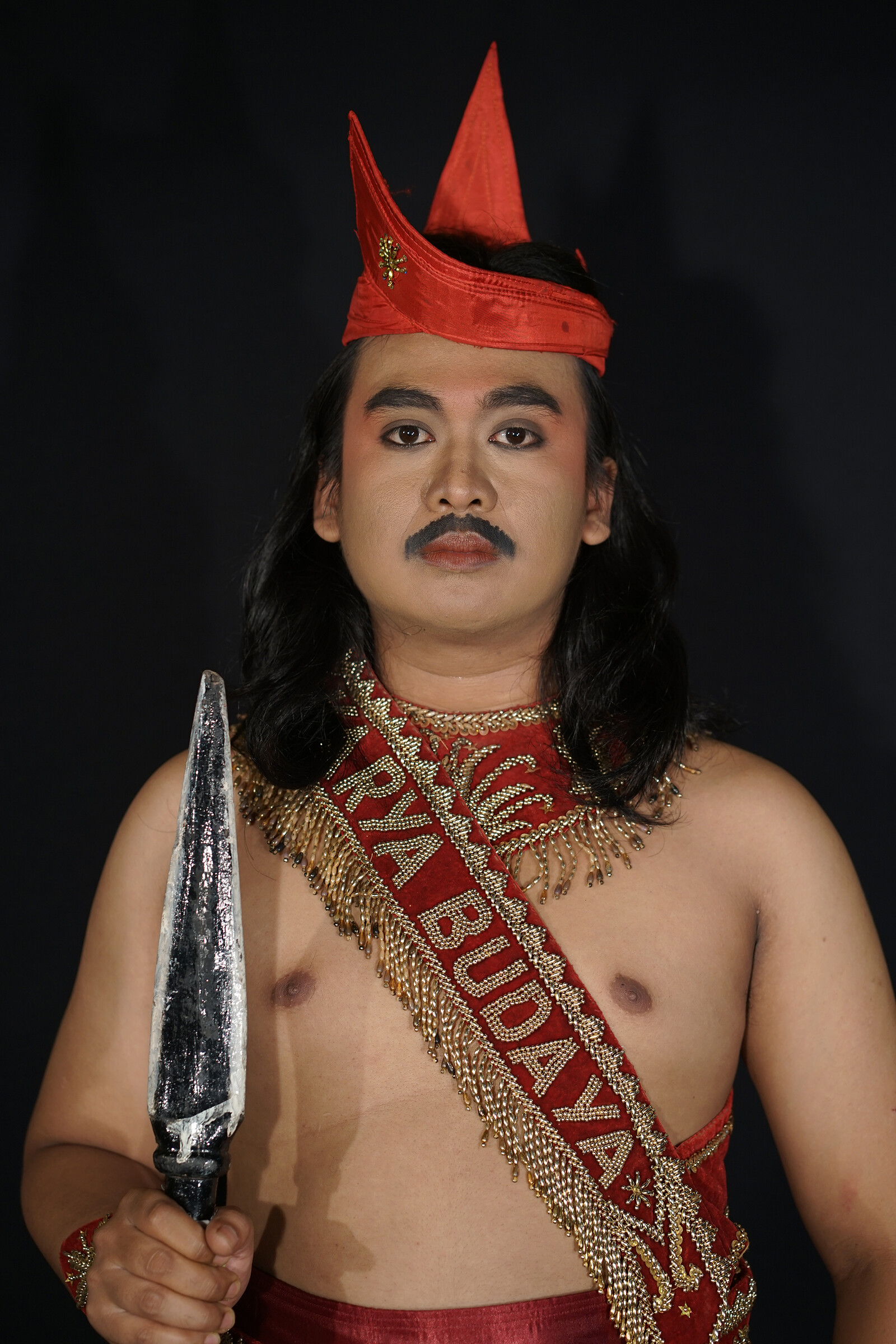
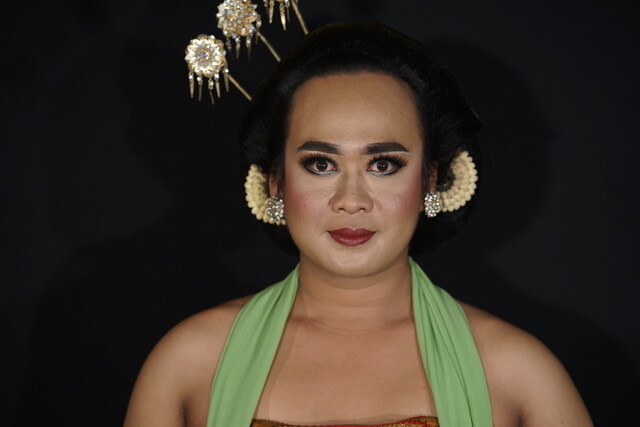
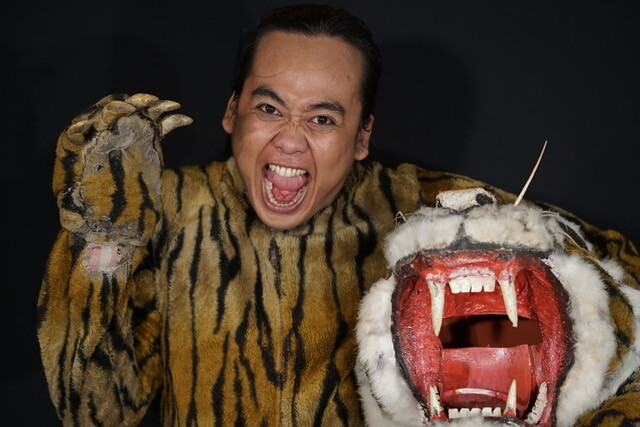
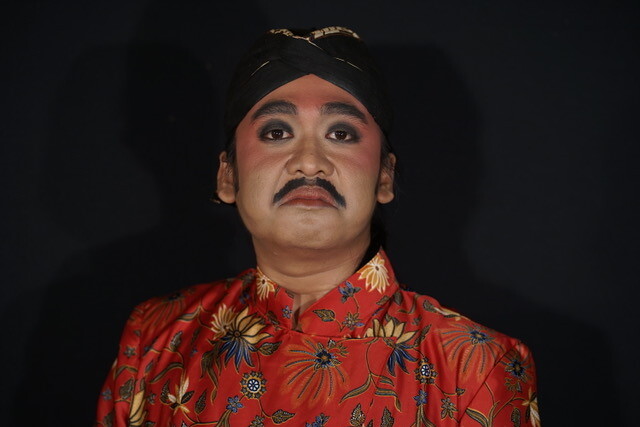

Photograph series courtesy of Tamarra.
RA: Were you curious to look at the old manuscript in regard to what happened in precolonial times?
T: Yes. We can also see relics in some temples in Java, too, if we want to see the precolonial version of gender, as the complexity of ancient texts makes them hard to read. It’s rare to find an educated person who can translate and contextualize them in our present. We can use puppetry (wayang) to talk about queerness in Javanese mythology. We can refer to the character of Arjuna, or to Srikandhi’s legendary fighting skills. Srikandhi is the reincarnation of Amba, a princess who magically goes through a genital change and is born with a female body.
RA: It reminds me of the epic story Mahabharata.5 In the chapter “Living in Disguise,” all the Pandavas are in exile and hiding. Arjuna disguises himself as a woman to teach dance and singing under the name Wijaya or Brihanala. Arjuna’s plan is to wear a women’s long-sleeved shirt to cover the bowstring scars on his arm. He also wears bracelets, necklaces, and earrings, and has his face made-up as a woman. When Arjuna refuses a woman’s advances, he is cursed to be a “sissy.” After that, whenever he wants, he can act like a woman.
If we look closely, the depiction of the figure of Arjuna in the Nusantara version of the Mahabarata story, especially in wayang orang (wayang performances played by actors), Arjuna’s figure is described as gentle, and having a slender, woman-like, femme aesthetic. The character is sometimes played by a woman.
T: Can you imagine going through kind of transformation back then? Seriously?! There were no razors, so how does he shave? Does he wear a wig, does he wear a headscarf? How does he transform his face into a woman? Can you imagine that kind of transformation taking place through make-up? Maybe he uses magic.
Since I study history, I realized that in the world of academia, a manuscript is not really used as a primary source because it is considered very metaphorical; it talks about things that are considered impossible. Most of these things are occult, mystical, or mythological, and when they are studied in academia, they are alienated from their cultural context. Scholars require evidence-based material, while the manuscript is considered inaccurate or has no logical explanation in terms of the reality that we believe in today.
We can also refer to Serat Centhini, the nineteenth-century compilation of Javanese tales in verse.6 Within it we have Cabolang’s story, which narrates a lot of sexual exploration with both the feminine and masculine sides that exist in him. Of course he exchanges these roles subtly through sexual activity either with cis men or cis women.
RA: The colossal work of Centhini explains class politics, gender, female behavior, sissy dancers, sexual relations, sexual orientation, and homosexuality. According to Benedict Anderson, the chronicles are considered an example of esoteric knowledge, but they also directly replicate the conditions of Javanese society in the nineteenth century.7 One character who does just that is Cabolang, who is an amateur artist who also possesses magic knowledge, plays musical instruments and dances, is inviting, and can amaze an audience.
T: A similar role—namely the agent of cultural tradition—is common in the art of certain Indonesian regions today. For instance, you see it in reog, which is a dance involving a large tiger mask plumed with peacock feathers and hobbyhorse dancers, commonly believed to have originated in Ponorogo.8 The gemblak is a character played by a younger male dancer, while the warok is in charge of leading the show. Their relationship has aspects of artistic mentorship, of father and son, but also a vague romantic/sexual bond. In Jombang and Mojokerto there’s ludruk, and you can say that sexual orientation becomes organic when men become waria.
RA: During the Dutch colonial period, there was the “vice scandal” of 1938–39, which was a remarkable mass arrest of homosexuals by special vice squads (zedenpolitie).9 And before that the police targeted immoral acts: prostitution and the trafficking of children and women. This turned out to be about maintaining propriety, about “civilizing” colonial society. Today we still hear about “maintaining public order,” also known as the illusion of “peace and order” (rust en orde in Dutch).
T: I think it’s “natural” that the Dutch negated all of that; the roots of colonialism are Catholic. They brought missionaries, they brought Abrahamic religions, they punished Sodom and Gomorrah.
In Indonesia there has been much discussion of the Criminal Code since 2016, and many have pointed out that it is a legacy of the Dutch colonial era, which introduced “modern“ colonial values. To this day, there are several laws that criminalize things that are very private, whether it’s sexuality or adult cohabitation (on a consensual basis, without coercion or violence). We bear witness to how Indonesia’s neighborhood associations, called Rukun Tetangga, can authorize raids on homes inhabited by couples who don’t have marital status. At a higher level of authority, the state can criminalize “strange behavior” in public spaces or make what in modern terms are LGBTQ+ people’s lives and actions “immoral” and punish them.
RA: Let’s discuss the issue of sexuality during colonial times. It relates to racism, in that there was a colonial authority for the enactment of regulations on sexuality and gender norms.
T: We can trace the gendered repression of Indonesian women to the idea of pergundikan, where Dutch men had marriage-like relationships with local women without being legally married. The role of the woman called a “nyai” is to work and serve her “master.” In addition to satisfying the lust of white men, she has to look after the house: “dapur, sumur, kasur” (kitchen, bathroom, and bedroom).
RA: As with many other folk arts, ludruk empowers proletarian struggle and resistance to authority. Ludruk has powerful tools to influence the masses. Would you like to draw out the ludruk context during Indonesia’s 1965 tragedy?
T: During my research into Karya Budaya, a ludruk group founded in Mojokerto in 1962, its founder’s son, Abah Edhi, told me that in the sixties ludruk was affiliated with Lekra (Peoples Cultural Institute), an artist organization in the 1950s and 60s that articulated the importance of arts of the people’s spirit.10 Although officially Lekra was not an organization of the PKI (Indonesian Communist Party), the revolutionary artistry of the reality of the lower classes, particularly that of the peasant, is a potential source of ideological similarity.
At that time, there were ludruk performances that had titles like Mass Circumcision for Angels and The Great Allah Throws Wedding Party for His Children, which were considered blasphemous. These plays basically aimed to offer a secular view and to counter feudal power. Many Muslims were disturbed by ludruk, so the people involved in it were accused of being communists.
RA: I’ll come back to your work on ludruk with the Karya Budaya group. For now, how do you see the life of transgender people in Indonesia today, based on your experience?
T: Overall, the majority of waria work as buskers or as sex workers. If they have enough money or are from a privileged family, they might start a business, usually related to the beauty industry, like a hair salon.
But it is hard for many transgender women to get support from their families. They all struggle in different ways. But those who are accepted by their families have a life that looks much better than that of other transgender people.
For example: Oscar Lawalata, a well-known Indonesian designer, recently came out publicly and now wants to be called Asa. Then there are other celebrities like Dena Rachman, who created a shoe brand called Drama, and Kevin Halim—they were both able to study abroad and received full support from their families.
It’s really complex, and often those who are in a good position are in the entertainment realm. The singer Lucinta Luna, for example, has appeared in many TV programs. Whether she is aware of it or not, her position boosts the idea that transgender people exist outside of television.
The idea of existence extends to acceptance. We always talk about the acceptance demanded by waria people. Lucinta Luna’s success in the realm of entertainment is also a form of acceptance. There are many haters, but that’s not the point.
RA: But does Lucinta Luna’s acceptance extend to other waria people? In daily life, queer and gender nonconforming people still have to explain themselves. Society tends to bully them when they do wrong, blame their orientation, and question the motivation of their actions. As if they can’t possibly be a good person. Society demonizes them.
T: I also think about the acceptance of our waria friends from our closest circle. I want to go back and ask, what kind acceptance do you mean? Because if you are really not accepted, then, for example, there’s no way you can live here in Jogja, there’s no way you can stay in Jogja.
What is the scope of acceptance that you want? Well, if you already have that knowledge, you will then automatically strategize about how to achieve the acceptance that matches the scope you want. Not constantly blaming the government, neighbors, or other parties. This is complicated, I mean … sssshh … if the conversation is like this, I can be in a position to defend my friends but also be in a position to dissent from them.
RA: You are an artist and a nonbinary person who is currently studying history, doing research. How do you navigate this?
T: For me, I know very well the extent of my acceptance and the extent of the equality I want. Why did I wait ten years before I went to college? Because I needed a stable income. I realized as an artist who did not have a good income, I could be overloaded, so I waited. Eventually, I decided to pursue my studies because I wanted to be equal to other scholars, to prove that I could enter college and express myself on campus.
If knew that if I wanted to be equal to other people, I had to find the kind of jobs that common people have. In 2013 I applied to Via-Via Restaurant, Tours & Events to become a guide. I have been a server in a coffee shop, and I have also worked at a mini-mart.
Anyway, in the case of waria, it’s a complicated. It’s different from gay or lesbian people. Some waria friends ran away from home when they were little and spent most of their life on the street. Theirs is the jungle mindset of “survival of the fittest.” If you’re hungry, you go hunting or working, you go out to have something to eat, then you feel full. Tomorrow you repeat it all again, so it continues. There are no strategies for saving for the future.
Then the biggest burden in my opinion comes from some of the NGOs. Waria people are constantly positioned as puppets, controlled. They are positioned as a minority, powerless, marginal, as the victim. They are lured by materiality. They need to have more support that is mental and spiritual, to have a better life.
“In no time, it will become history”—huh?! My psychologist suddenly texted me, look!
RA: I believe your career as an artist started with the Makcik Project. What was this project, and what was your involvement?
T: The Makcik Project worked with transgender women in Jogyakarta. It was initiated by artists and curators in 2011–13. At that time I was a busker and a sex worker. I learned many things from this project, including how to hang out with people outside my own community. When you break your walls, you will of course encounter many things in this world, like knowledge, relationships, experiences, etc.
My departure from Makcik can also be read very easily. I was one of the waria involved in the Makcik Project, then I chose to become an artist. I began to learn new things, especially related to artmaking. The Makcik Project changed my way of thinking.
Of course, the journey to become an artist has not been as smooth as I imagined. For example, the first time I collaborated with another artist, my name was not mentioned during the exhibition. I was not considered and not recognized at all even though I was there. Things like that then became a whip propelling me forward, and I didn’t want to give up.
Financially speaking, busking and sex work are more profitable. The way I live now can be measured against my past when I was a busker. Now I am also more prosperous in the sense of being self-sufficient. That gives me a status beyond being considered a victim, marginalized by the state or society.
RA: But to get to that position, do you feel that you have been privileged?
T: Mine is not a matter of privilege or capital. You can call me shameless yet curious! Hahaha.
RA: So you want all of your friends to have those qualities?
T: Hahaha, not in that way! I mean I know how to make the most out of a situation. For example, when we went on a studio visit during the Makcik Project, my friends just listened. Because I’m shameless, I asked a lot of questions out of curiosity. If I’m really interested in an object or approach, I’ll ask and ask, and demand that others teach me.
There was a leap forward in the Makcik Project. I am used to being interviewed in a way where my story is being collected as data or testimony. You can earn some money from this kind of encounter. In Makcik there were no financial transactions like this, so instead my automatically transactional mind looked for other things to get from the project, like skills, knowledge, networking, or whatever. So through Makcik, money turned into other kinds of value.
RA: Let’s talk about your practice as an artist, particularly your photo work with the Karya Budaya ludruk group. I am interested in your performance of multiple identities.
T: It’s very close to how I perform as a person. Changing from one to the other can’t be avoided in the wider community when it comes to survival in Indonesia, and I realize that. For example, when I go to the hospital or when I manage state bureaucracy, I have to perform as Adam.11
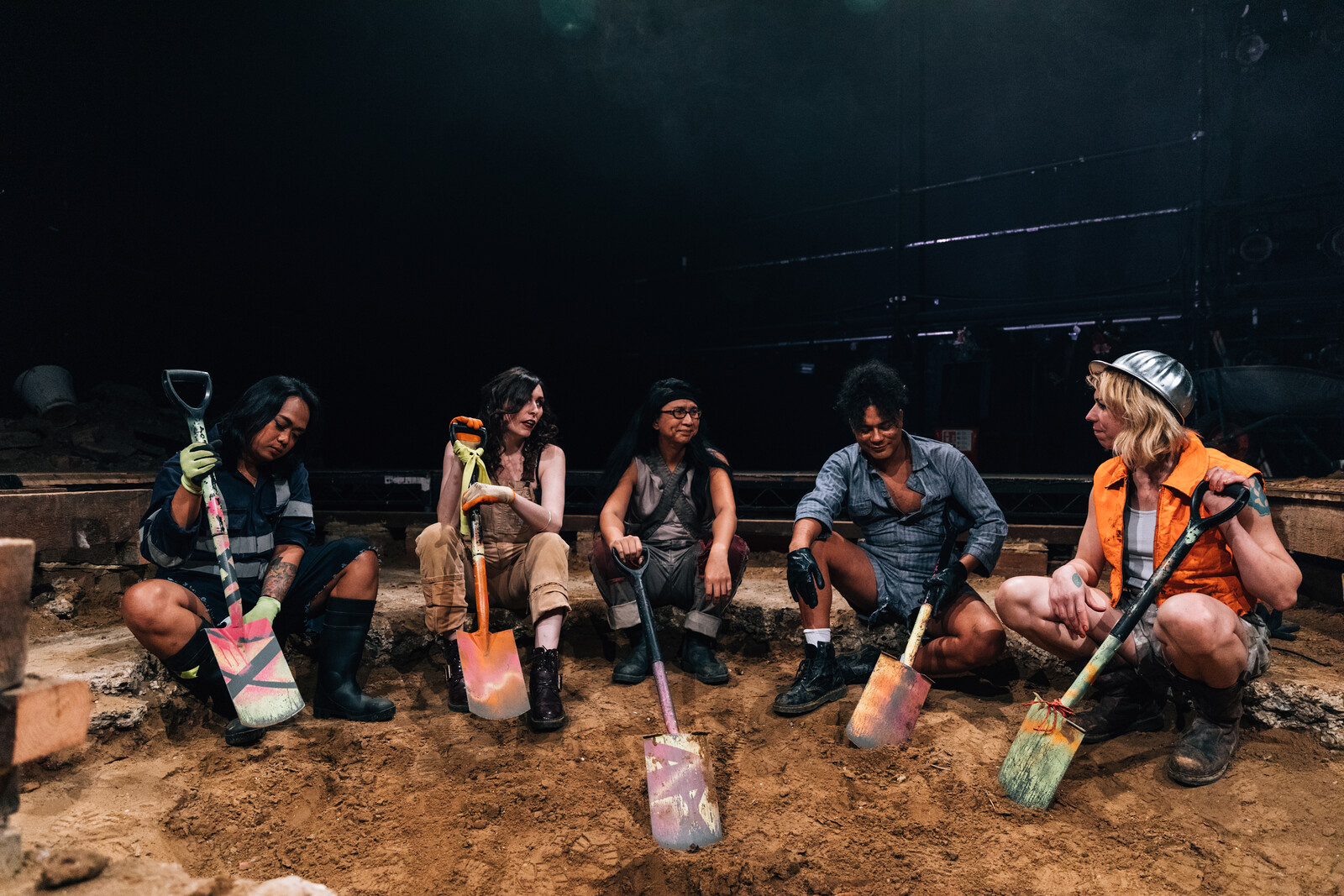
Tamarra in We Dig at Ovalhouse London, 2019. Photo: Rosie Powell.
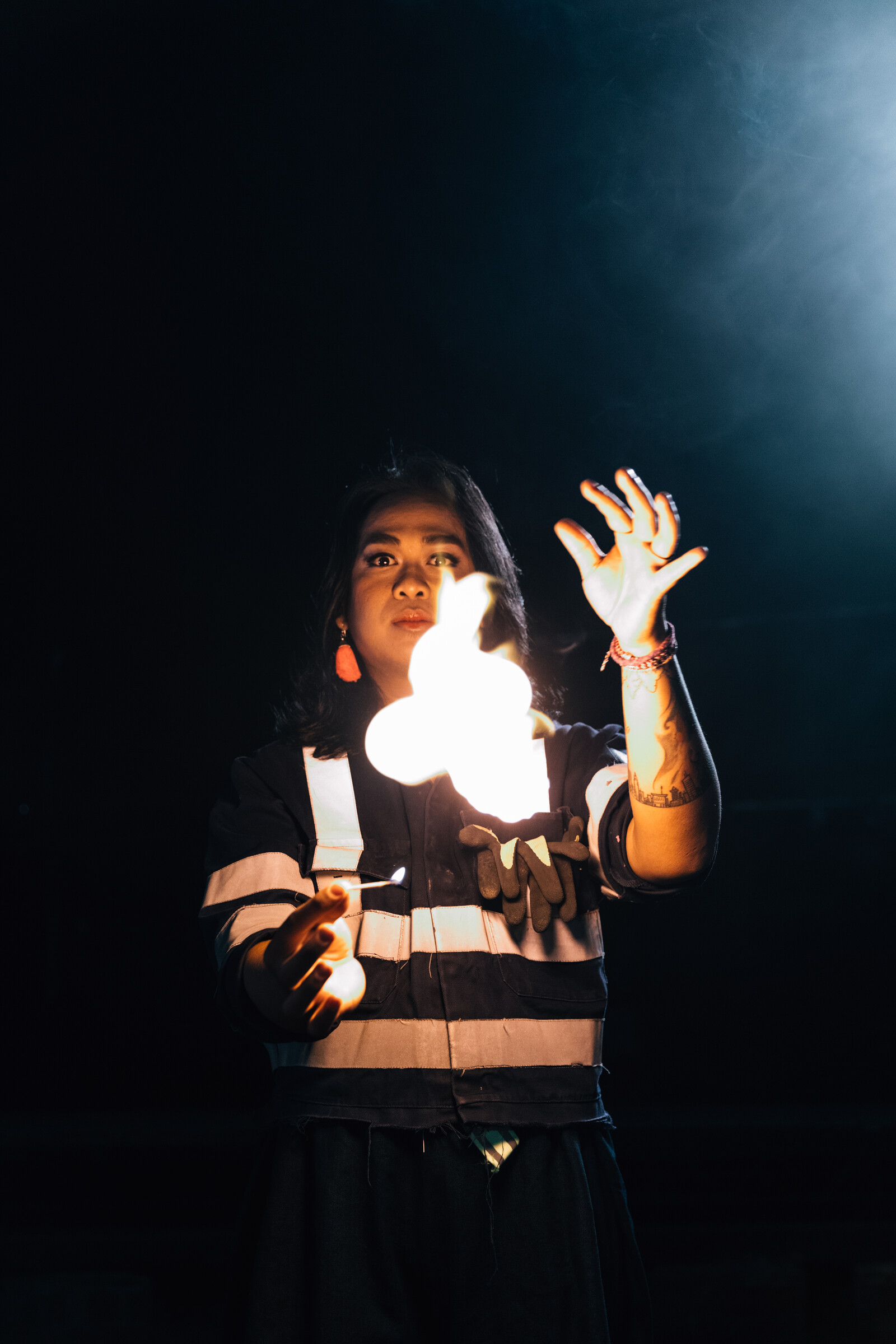

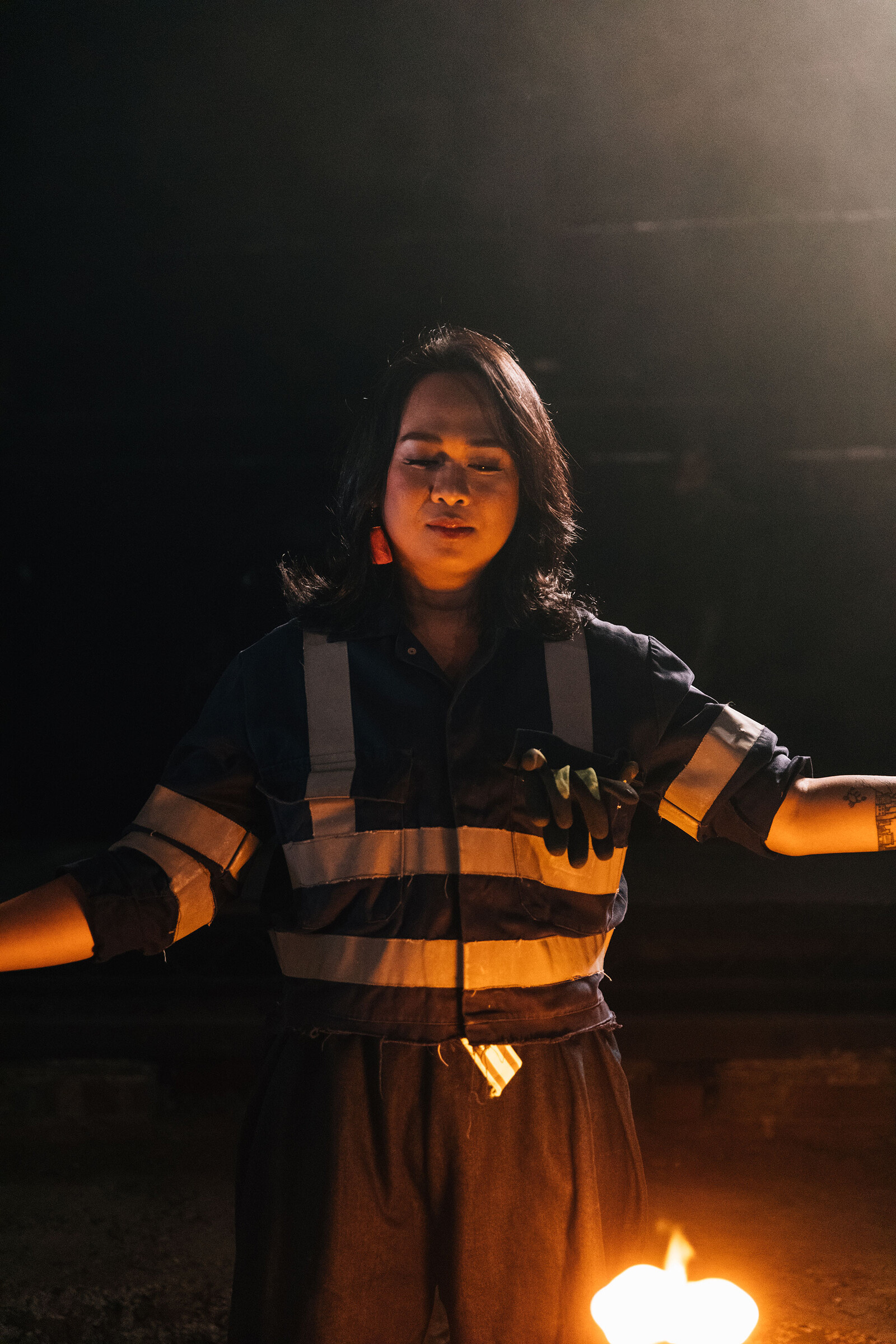
Tamarra in We Dig at Ovalhouse London, 2019. Photo: Rosie Powell.
RA: How about your cross-dressing research?
T: That’s all my life. You have to understand that feminine and masculine sides exist in all bodies and that they can be exchanged very subtly. The expression of that mastery is to cross-dress. I articulate all of that in my photos taken in Mojokerto with the members of the Karya Budaya group.
My goal with these photos was to archive ludruk costumes and their history. Each costume has its own history and its own reasons for existing. None of this knowledge had been archived because it belongs to an oral culture, so for me it’s very important to document ludruk characters and figures.
On the other hand, it is also important for Karya Budaya and for other people to have my work as an archive for future reference. Karya Budaya already has a fairly complete archive of the works I digitized. Other archives, the tangible ones, like awards and notes, have been damaged. The roles performed by each of the ludruk characters are spoken over and over again through verbal communication. I help to document this speech in various forms: notes, videos, movies, photos. As I learned in my historical studies, everything can be considered a text.
In my opinion, these archives are important, not only for me and for the current members of Karya Budaya. I also hope that they demonstrate to other ludruk groups that archives are important, history is important. Ludruk is not only a spectacle but also a medium for recording the sociopolitical development of the surrounding community.
RA: Tell us about your negotiations with the performers in Karya Budaya. You emphasize on the one hand that the photographs are the work of Tamarra the artist, yet on the other they are an archive for Karya Budaya. The way they can use the photographs is different from the way you can use them, right? For example, they can’t show them as artworks in an exhibition.
T: Yes, the photographs aren’t to be sold or traded; they only function as an archive for Karya Budaya.
RA: How did you make a deal with them?
T: Abah Edi offered me an artist’s contract with the group. I was surprised. Perhaps he also felt that my work helped them to recollect or recompose their story. What surprised me the most was when I found out why these characters weren’t archived: the idea of archiving simply has no strong presence in their tradition. During my research, I was awakened to how my visual practice could work to archive traditional art materials that are usually part of an orally disseminated body of knowledge.
RA: The performativity in your work opens up the possibility of staging new iterations of a play, a character, a gender. Why did you decide to perform some of the ludruk figures yourself?
T: First, because I didn’t have the budget to pay ludruk performers to play all of the characters themselves. There were also time constraints. And I was thinking of the makeup artists. The one who helped me was Ms. Yeyen, one of the tandak (transwomen) in Karya Budaya. She was already overwhelmed enough!
These considerations are why I chose to work with my own body. There was a question I really wanted to pose to the wider community, especially to waria people: Why are you happy to be in just one group, which negates other possibilities? The point is to understand that femininity and masculinity are in everyone’s body. That’s all. The rest you just perform. This has nothing to do with your sexual orientation, your gender expression, what kind of sexual behavior you engage in; it doesn’t have anything to do with all that. This is our problem in society, right? When it comes to talking about LGBTQ+ issues, it’s a cliché in my opinion to always talk merely about the crotch.
RA: What’s behind your preference for using your own body, not another person’s body? I remember a performance where you just repeated “Hello, my name is Tamarra” over and over again for an hour. Was it about reclaiming, or renaming? Is it a matter of reappropriating your trans-body?
T: That was right at the beginning, when I first became a performance artist. Because of various limitations, I concluded, “my body is my stage” rather than being tied to a “stage” or a space.
When I narrate the knowledge I have learned from one of my research subjects, I choose to present my own body, not the body of the person I researched. I can’t help but be part of them. I am of the same community.
There are many ways to change one’s face in order to perform a different character—through makeup, for example. But I don’t want to represent other people in my work. Representing their knowledge is the key.
RA: Is that related to the idea of “staging” in both ludruk and in your everyday life? In both, you are appearing and performing, so it’s like ludruk and everyday life mirror each other.
T: The space you’re in determines whether your gender expression is accepted. It could be that the people in the ludruk group are accepted on stage, but when they’re off stage and mingling with the community, they are not necessarily accepted.
The ludruk players not only perform in their own village; they are also nomadic, traveling to other villages to perform. When the show starts, people come, but only the ones who can accept and be entertained by the ludruk spectacle. Of course, people who are anti-travesti or anti-tandak will not come.
So you also need to specify a certain scope and stage for gender expression in order to determine what its agency is. With my new short-haired look, my family and friends who expect me to “come back” say that from their normative perspective, they want me to be straight Adam Muloh. They like my new look! My LGBTQ+ friends think this is harassment. They have the impression that Tamarra is a waria who is easygoing, and that I can (dis)assemble myself anytime I want. They think that Tamarra is gay. Even my closest community doesn’t understand my sexual orientation or sexual behavior. I’m disappointed that my queer friends still adopt a heterosexual perspective. Why do we have to police each other? For example, if you are transgender, why do you have to groom, wear women’s clothes, wear makeup, and so on?
RA: Why don’t you talk about your collaboration with Emma Frankland and the transfeminine artist friends at the We Dig! show in London in 2019.12
T: It’s worth mentioning that before collaborating with Emma, I worked with Ming Wong, an artist who shares my concerns and approaches to performance art. In 2015 Ming Wong, Shahmen Suku, Bradd Edwards, and I performed Aku Akan Bertahan / I Will Survive, which was part of the Asia Pacific Triennial of Contemporary Art at GOMA in Brisbane.13 Through my involvement in Ming Wong’s project, I saw how Ming tries to represent queer culture in Jogja through references to western films that he re-creates in his work.
When I worked with Emma on We Dig! in the UK, I experienced my first welcoming ritual. It was so amusing! Emma asked us to walk on a beach and have a potluck as a ritual for introducing ourselves to Emma’s homeland. Then there were months of preparation. We all got per diems once we arrived, so we could easily organize ourselves! Sometimes, when I wanted to, I partied between the venue and the house.
It was facilitated in such a manner that they took care of our mental health. They were always checking on how we were doing, making sure we were comfortable enough to get through the day. There was a sense that they were creating a safe place for us to work together. Sometimes a psychologist arrived, and we had a chance to talk about the work, but nothing was mandatory. You got to decide if wanted to talk or not.
In terms of production, the plan was to dig up the earth under the stage of the Ovalhouse Theater in Brixton with shovels, and at the same time to dig up trans stories from our different perspectives.
RA: Interesting that you highlight the safe space there. I wonder if we could have that situation in our art spaces in Indonesia.
T: It’s very important, especially for us. There are many cases of anti-trans violence in film, theater, and art production spaces.
RA: The spaces that are managed by most of these heteros are all about jargon, right? They say “nonhierarchical,” they say “inclusive” … blegh.
T: We both know that more than a few of those spaces have seen violent incidents, but they’re hidden and forgotten. I’ve had personal experience with this too. It just comes down being treated fairly, right? I console myself by remembering that my very existence is a “threat” to them, and I just focus on myself.
RA: In the future, would you be able to share or translate your We Dig! experience into an organizational philosophy for art spaces here in Indonesia?
T: To build a better workspace for us? Yeah, why not? I am happy to do that.
In the 1960s a popular term referring to transgender people was “wadam,” which is a combination of “wanita” (women) and “Adam.” However, religious groups objected to the term because it uses the name of a prophet, Adam. The term was associated with the establishment of an organization called Himpunan Wadam Djakarta (HIWAD). In the Queer Indonesia Archive (QIA), two sources provide different years for when HIWAD was established: GAYaNUSANTARA no. 108 (August 2003) gives the year 1969, while Kemala Atmojo’s book Kami Bukan Laki-Laki: Sebuah SketsaKehidupan Waria (1986) gives the year 1973. In this conversation we use “waria” to refer to transgender woman. Apart from this, in Indonesia today, we use “transpuan”; “puan” derives from “perempuan” (woman), a synonym for “wanita” (woman).
Mentioned in the introduction to Dede Oetemo, Memberi Suara pada Yang Bisu (Giving voice to the voiceless) (Galang Press, 2001).
See Andi Zainal Abidin and C. C. Macknight, “The I La Galigo Epic Cycle of South Celebes and Its Diffusion,” Indonesia, no. 17 (April 1974): 161–69 →.
The Indonesian version was compiled by Nyoman S. Pendit, Mahabharata (Gramedia Pustaka Utama, 2003).
Soewito Santoso, Fendi Sirefar, and Kestity Pringgoharjono, The Centhini Story: The Javanese Journey of Life (Marshall Cavendish, 2006).
Benedict Anderson, Language and Power: Exploring Political Cultures in Indonesia (Cornell University Press, 1990).
See Ian Douglas Wilson, “The Politics of Possession: Community Arts in New Order Java” (honor’s thesis, Murdoch University, 1997).
See Marieke Bloembergen, “Being Clean Is Being Strong: Policing Cleanliness and Gay Vices in the Netherlands Indies in the 1930s,” in Cleanliness and Culture: Indonesian Histories, ed. Kees van Dijk and Jean Gelman Taylor (Brill, 2012).
Throughout this interview process, Tamarra informed me at the end of January 2021 that Tamarra was in court to change Tamarra’s name and all identification documents. As written on an identity dard on February 20, 2021 passed by the Yogyakarta District Court. Tamarra’s pronoun is Tamarra.
See →.
See →.
Category
Riksa Afiaty would like to thank Tyson Campbell, Syafiatudina and Sidhi Vhisatya for their clarity that significantly improved the text.
